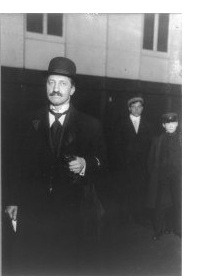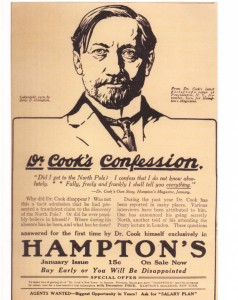The Centennial of Dr. Cook’s “confession.”
Written on January 14, 2011

In 1910 Hampton’s Magazine paid Peary $40,000 for the rights to his serialized narrative of his conquest of the pole. This series turned out to be a financial disaster, failing to recoup even this, much less the additional $50,000 Benjamin Hampton spent on advertising it. Perhaps to try to recover his loses, he secretly negotiated a similar series from Frederick Cook, then living secretly in London. Hampton’s idea was to have Cook write an account of why he faked his polar attempt, but Hampton’s agents found Cook unwilling to make any such admission. Cook duly wrote a series of articles for Hampton in which he attempted to explain his recent disappearance and to allege a conspiracy of big money and power had deprived him of his accomplishment. Once written, Hampton’s editors struck out most of the anti-Peary statements and played up Cook’s frank admission that it was impossible to say if he had actually reached the exact mathematical point known as the North Pole.
Their changes gave an appearance of mental delusion or doubt that he came anywhere near it. Hampton then promoted the story as “Dr. Cook’s Confession.” The first installment of the series, which ran from January to April 1911, was on the news stands when Cook returned to America in late December 1910 (picture above). Although this sequence of events has been decried as one of the most dastardly deeds in the history of journalism by Cook’s proponents, actually, beyond the contradictory doubts expressed in the first of four articles, the material published by Hampton’s was largely incorporated into Cook’s eventual book, My Attainment of the Pole, so his subsequent renouncement of the articles was only partially sincere. Only the last installment found no place in the book. In denouncing the articles in 1911, Dr. Cook confirmed this: “The articles that eventually appeared in Hampton’s, with the exception of unauthorized editorial changes and excisions of vitally important matter concerning Mr. Peary, were practically the same as planned in London. From a business standpoint, it was a poor decision. Hampton lost even more money as a result, forcing his magazine into receivership the next year.
Filed in: Uncategorized.